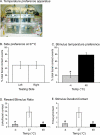Characterization of cold sensitivity and thermal preference using an operant orofacial assay
- PMID: 17166284
- PMCID: PMC1764875
- DOI: 10.1186/1744-8069-2-37
Characterization of cold sensitivity and thermal preference using an operant orofacial assay
Abstract
Background: A hallmark of many orofacial pain disorders is cold sensitivity, but relative to heat-related pain, mechanisms of cold perception and the development of cold allodynia are not clearly understood. Molecular mediators of cold sensation such as TRPM8 have been recently identified and characterized using in vitro studies. In this study we characterized operant behavior with respect to individually presented cold stimuli (24, 10, 2, and -4 degrees C) and in a thermal preference task where rats chose between -4 and 48 degrees C stimulation. We also evaluated the effects of menthol, a TRPM8 agonist, on operant responses to cold stimulation (24, 10, and -4 degrees C). Male and female rats were trained to drink sweetened milk while pressing their shaved faces against a thermode. This presents a conflict paradigm between milk reward and thermal stimulation.
Results: We demonstrated that the cold stimulus response function was modest compared to heat. There was a significant effect of temperature on facial (stimulus) contacts, the ratio of licking contacts to stimulus contacts, and the stimulus duration/contact ratio. Males and females differed only in their facial contacts at 10 degrees C. In the preference task, males preferred 48 degrees C to -4 degrees C, despite the fact that 48 degrees C and -4 degrees C were equally painful as based on their reward/stimulus and duration/contact ratios. We were able to induce hypersensitivity to cold using menthol at 10 degrees C, but not at 24 or -4 degrees C.
Conclusion: Our results indicate a strong role for an affective component in processing of cold stimuli, more so than for heat, which is in concordance with human psychophysical findings. The induction of allodynia with menthol provides a model for cold allodynia. This study provides the basis for future studies involving orofacial pain and analgesics, and is translatable to the human experience.
Figures



Similar articles
-
Characterization of mouse orofacial pain and the effects of lesioning TRPV1-expressing neurons on operant behavior.Mol Pain. 2008 Oct 1;4:43. doi: 10.1186/1744-8069-4-43. Mol Pain. 2008. PMID: 18828909 Free PMC article.
-
Operant behavioral responses to orofacial cold stimuli in rats with chronic constrictive trigeminal nerve injury: effects of menthol and capsazepine.Mol Pain. 2013 Jun 14;9:28. doi: 10.1186/1744-8069-9-28. Mol Pain. 2013. PMID: 23767981 Free PMC article.
-
The effects of a co-application of menthol and capsaicin on nociceptive behaviors of the rat on the operant orofacial pain assessment device.PLoS One. 2014 Feb 18;9(2):e89137. doi: 10.1371/journal.pone.0089137. eCollection 2014. PLoS One. 2014. PMID: 24558480 Free PMC article.
-
TRPM8: from cold to cancer, peppermint to pain.Curr Pharm Biotechnol. 2011 Jan 1;12(1):68-77. doi: 10.2174/138920111793937961. Curr Pharm Biotechnol. 2011. PMID: 20932257 Review.
-
TRPM8 ion channel ligands for new therapeutic applications and as probes to study menthol pharmacology.Life Sci. 2013 Mar 19;92(8-9):425-37. doi: 10.1016/j.lfs.2012.10.032. Epub 2012 Nov 16. Life Sci. 2013. PMID: 23159643 Review.
Cited by
-
Topical application of L-menthol induces heat analgesia, mechanical allodynia, and a biphasic effect on cold sensitivity in rats.Behav Brain Res. 2010 Oct 15;212(2):179-86. doi: 10.1016/j.bbr.2010.04.015. Epub 2010 Apr 14. Behav Brain Res. 2010. PMID: 20398704 Free PMC article.
-
Operant nociception in nonhuman primates.Pain. 2014 Sep;155(9):1821-1828. doi: 10.1016/j.pain.2014.06.010. Epub 2014 Jun 23. Pain. 2014. PMID: 24968803 Free PMC article.
-
Influence of TRPV1 on Thermal Nociception in Rats with Temporomandibular Joint Persistent Inflammation Evaluated by the Operant Orofacial Pain Assessment Device (OPAD).J Pain Res. 2023 Jun 15;16:2047-2062. doi: 10.2147/JPR.S405258. eCollection 2023. J Pain Res. 2023. PMID: 37342611 Free PMC article.
-
"Bedside-to-Bench" Behavioral Outcomes in Animal Models of Pain: Beyond the Evaluation of Reflexes.Curr Neuropharmacol. 2013 Dec;11(6):560-91. doi: 10.2174/1570159X113119990041. Curr Neuropharmacol. 2013. PMID: 24396334 Free PMC article.
-
Adaptation of a novel operant orofacial testing system to characterize both mechanical and thermal pain.Behav Brain Res. 2011 Mar 1;217(2):477-80. doi: 10.1016/j.bbr.2010.10.022. Epub 2010 Oct 23. Behav Brain Res. 2011. PMID: 20974188 Free PMC article.
References
Publication types
MeSH terms
Substances
Grants and funding
LinkOut - more resources
Full Text Sources

